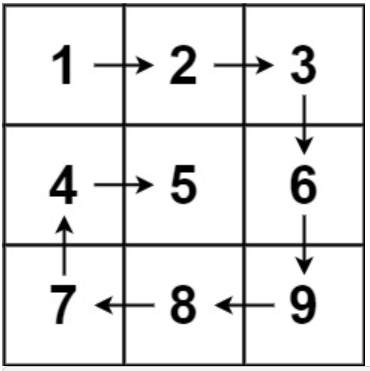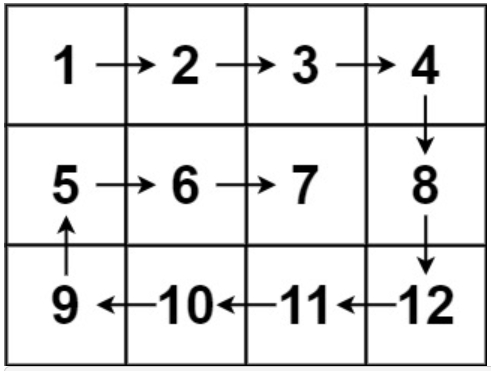Introduction to 2D Array
本文蒐集
LeetCode 498: Diagonal Traverse
Given an m x n matrix mat, return an array of all the elements of the array in a diagonal order. Example 1: 
Input: mat = [[1,2,3],[4,5,6],[7,8,9]]
Output: [1,2,4,7,5,3,6,8,9]Input: mat = [[1,2],[3,4]]
Output: [1,2,3,4]m == mat.lengthn == mat[i].length- 1 <= m, n <= \(10^4\)
- 1 <= m * n <= \(10^4\)
- \(-10^5\) <=
mat[i][j]<= \(10^5\)
我的解法 1
利用原始 dict 字典 mapping 和原始 list 串列 當作 queue
class Solution:
def findDiagonalOrder(self, mat: List[List[int]]) -> List[int]:
d={}
for i in range(len(mat)):
for j in range(len(mat[i])):
if i + j not in d:
d[i+j] = [mat[i][j]]
else:
d[i+j].append(mat[i][j])
ans= []
for entry in d.items():
if entry[0] % 2 == 0:
entry[1].reverse()
ans.extend(entry[1])
return ans我的解法 2
利用 python 內建實用 Lib collections
- 增加便利性
- 減低時間複雜度
collections.defaultdict() mapping 和 collections.deque() queue
class Solution:
def findDiagonalOrder(self, mat: List[List[int]]) -> List[int]:
ans = deque()
d = defaultdict(deque)
for i in range(len(mat)):
for j in range(len(mat[0])):
d[i+j].append(mat[i][j])
for k, v in d.items():
if k % 2 == 0:
v.reverse()
ans.extend(v)
return ansLeetCode 54: Spiral Matrix
Given an m x n matrix, return all elements of the matrix in spiral order. Example 1: 
Input: matrix = [[1,2,3],[4,5,6],[7,8,9]]
Output: [1,2,3,6,9,8,7,4,5]
Input: matrix = [[1,2,3,4],[5,6,7,8],[9,10,11,12]]
Output: [1,2,3,4,8,12,11,10,9,5,6,7]m == matrix.lengthn == matrix[i].length1 <= m, n <= 10-100 <= matrix[i][j] <= 100
我的解法
class Solution:
def spiralOrder(self, matrix: List[List[int]]) -> List[int]:
visited = set()
ans = deque()
m = len(matrix)
n = len(matrix[0])
i = -1
j = -1
flag = 0
while len(visited) != m * n:
if flag % 4 == 0:
i += 1
j += 1
while 0 <= j < n and (i, j) not in visited:
ans.append(matrix[i][j])
visited.add((i, j))
j += 1
flag += 1
elif flag % 4 == 1:
j -= 1
i += 1
while 0 <= i < m and (i, j) not in visited:
ans.append(matrix[i][j])
visited.add((i, j))
i += 1
flag += 1
elif flag % 4 == 2:
i -= 1
j -= 1
while 0 <= j < n and (i, j) not in visited:
ans.append(matrix[i][j])
visited.add((i, j))
j -= 1
flag += 1
else:
j += 1
i -= 1
while 0 <= i < m and (i, j) not in visited:
ans.append(matrix[i][j])
visited.add((i, j))
i -= 1
flag += 1
return ansLeetCode 118: Pascal's Triangle
Given an integer numRows, return the first numRows of Pascal's triangle.
In Pascal's triangle, each number is the sum of the two numbers directly above it as shown: 
Example 1:
Input: numRows = 5
Output: [[1],[1,1],[1,2,1],[1,3,3,1],[1,4,6,4,1]]Input: numRows = 1
Output: [[1]]1 <= numRows <= 30
我的解法
class Solution:
def generate(self, numRows: int) -> List[List[int]]:
ans = deque()
for i in range(numRows):
temp = deque()
for j in range(i+1):
if j == 0 or j == i:
temp.append(1)
else:
temp.append(ans[i-1][j-1] + ans[i-1][j])
ans.append(temp)
return ans